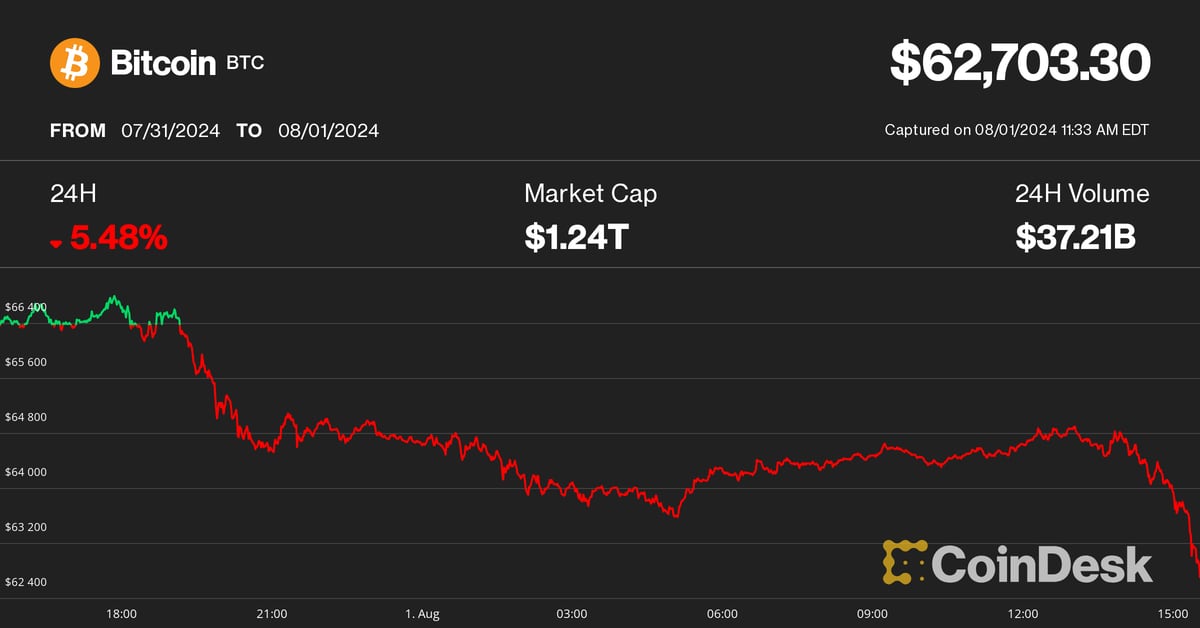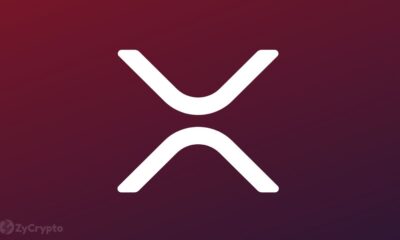Blockchain
Why High Cryptocurrency Volatility Can Be a Good Thing for Investors

Today’s newsletter marks my one year anniversary of curating the Crypto for Advisor newsletter. Time flies when you’re having fun, and it’s hard to believe I’m 52 issues under my belt. Thank you to CoinDesk and especially Kim Klemballa for giving me this opportunity along with all of our valued newsletter contributors who dedicate their time to building this industry, as your contributions are invaluable. As we continue our crypto journey together, I hope to see new contributors and continued engagement with ideas and topics as we strive to provide advisor education globally. Your educational needs, opinions, and insights are what shape this newsletter, as it truly is Crypto for Advisors!
We know the last couple of years have been challenging in the cryptocurrency industry, but 2024 has brought back excitement and energy. We are seeing many exciting product launches and regulatory advancements. I look forward to continuing to provide content to our valued audience and keeping them informed of timely and relevant developments.
In today’s issue, André Dragosch, head of research at ETC Group, discusses the volatility of cryptocurrencies, including bitcoin and ether, and how they compare to other emerging technology investments. Bryan Courchesne, CEO of DAIM, explains how advisors can manage cryptocurrency volatility in client portfolios.
Happy Independence Day to our American readers.
Traditional financial investors tend to avoid cryptocurrencies due to their high volatility.
To be fair, cryptocurrency volatility is relatively high compared to traditional asset classes like stocks, bonds, and most commodities.
Over the past three months, the annualized volatility of bitcoin and ether has been 45% and 50%, respectively, while the S&P 500 volatility has been around 15%.
A recent survey of institutional investors by Fidelity also identified high volatility as the main obstacle to investing in cryptocurrencies.
However, the truth is that high returns come with high risks, namely volatility.
In other words, where there is growth, there is volatility.
Most stock investors know this, as most large-cap, high-growth stocks, like Tesla, still tend to have high double-digit volatility.
Will the tokenization of real-world assets (RWA) take hold and Ethereum become the go-to platform?
Will Bitcoin Replace the US Dollar as the Global Reserve Currency?
While these types of scenarios have become increasingly likely in recent years, there remains a climate of uncertainty surrounding these issues.
Uncertainty tends to create volatility.
Amazon’s story holds important lessons in this regard. In the late 1990s, most Wall Street analysts thought “selling books online” was a silly idea. There was a lot of uncertainty about whether online retailing and the Internet in general would go mainstream.
Just as uncertainty around technology has decreased, Amazon stock price volatility has also decreased over time.
Few investors seem to remember that in the late 1990s, Amazon stock had annualized volatility of over 300%; today, volatility is well below 50%.
We have already observed a similar structural decline in volatility in the case of cryptocurrencies.
One reason is that bitcoin’s scarcity has increased with each halving, making it more “gold-like.” Halvings are best understood as a supply shock that cuts bitcoin’s supply growth in half (-50%). Thus, bitcoin’s character as an asset class has changed over time
While bitcoin volatility was around 200% during the first epoch, the roughly four-year time span between the cryptocurrency’s pre-scheduled “halvings” of miner rewards, up until 2012, has dropped to just 45% more recently. Similar observations can be made regarding ether.
In a 60/40 global stock-bond portfolio, the maximum Sharpe ratio is achieved by increasing the bitcoin allocation to about 14%, at the expense of the global equity weighting.
The Sharpe ratio of major cryptocurrencies such as bitcoin or ether is significantly above 1, meaning that investors are more than compensated for being exposed to greater volatility.
Looking ahead, the decline in volatility is set to continue with each new halving. The next one is scheduled for 2028.
The increasing adoption of this technology by institutional and retail investors is also expected to structurally reduce volatility over time.
The reason is that increasing heterogeneity among investors will lead to greater dissent among buyers and sellers, which will dampen volatility: the essence of Edgar Peters’s fractal market hypothesis.
Remember: where there is growth, there is volatility.
Q. How can advisors help their clients manage cryptocurrency volatility?
A. Cryptocurrencies, in their short history, have undoubtedly been a volatile asset. But that doesn’t mean they should be ignored by advisors. Advisors shouldn’t look at assets in isolation, but rather how they interact with others in a well-balanced portfolio. Diversification is key when building a portfolio that can deliver long-term results. Asset prices move in cycles, sometimes together but more or less distinct. This can be measured by an asset’s correlation with other assets. A lower correlation means the assets are less likely to move together. If one asset is up 35% for the year, another asset might only be up 4%. If assets are negatively correlated, one asset will rise over a given period while the other falls. This is important in the context of an investment portfolio because while assets can be volatile on their own, including them with other, less correlated assets can reduce the overall volatility of a portfolio.
Q. Is there a correlation between the volatility of cryptocurrencies and that of other assets?
A. In terms of correlation, a volatile asset like cryptocurrency is actually very important to reduce the overall volatility of a portfolio. Reducing the overall volatility of a portfolio is important because it helps to smooth out investment returns over time. This is important for many reasons. For example, an investor may have significant and unpredictable liquidity needs. If they have a portfolio of highly correlated assets and those assets are experiencing poor returns, they would withdraw a larger percentage of their portfolio than if they were to have a portfolio that included less correlated assets. Cryptocurrencies, having a low correlation to traditional assets, could help in this regard. Their volatility has historically been positively skewed, so even if it has large swings, when all other assets are down, it can provide a cushion to your portfolio. Smoothing returns also helps from a cognitive perspective for most investors. People can get too emotional when looking at their portfolio performance. Big price moves have a visceral effect, where big moves up make people want to buy more (usually right before a dip) and big moves down make people shy away and pull out (right before performance rebounds). Including at least a small portion of cryptocurrency (less correlated) in a portfolio smooths out its returns, so when investors check in, they see more modest gains or losses. This helps keep the portfolio out of sight and mind, which generally improves the chances of long-term success. Cryptocurrency, while volatile, should not be viewed in isolation, but in the context of how it can help create a truly diversified portfolio that will help build long-term wealth for investors.
Note: The views expressed in this column are those of the author and do not necessarily reflect those of CoinDesk, Inc. or its owners and affiliates.
Blockchain
Bitcoin (BTC) Price Crashes as Donald Trump’s Win Odds Dip

Markets received nominally good news on Thursday morning, with the US ISM manufacturing PMI for July falling much more than economists expected, sending interest rates to multi-month lows across the board. Additionally, initial jobless claims in the US jumped to their highest level in about a year. Taken together, the data adds to the sentiment that the US is on the verge of a cycle of monetary easing by the Federal Reserve, which is typically seen as bullish for risk assets, including bitcoin.
Blockchain
Terra Blockchain Reboots After Reentry Attack Leads to $4M Exploit

Please note that our Privacy Policy, terms of use, cookiesAND do not sell my personal information has been updated.
CoinDesk is a awarded press agency that deals with the cryptocurrency sector. Its journalists respect a rigorous set of editorial policiesIn November 2023, CoinDesk has been acquired from the Bullish group, owner of Bullisha regulated digital asset exchange. Bullish Group is majority owned by Block.one; both companies have interests in a variety of blockchain and digital asset businesses and significant digital asset holdings, including bitcoin. CoinDesk operates as an independent subsidiary with an editorial board to protect journalistic independence. CoinDesk employees, including journalists, are eligible to receive options in the Bullish group as part of their compensation.
Blockchain
$6.8M Stolen, ASTRO Collapses 60%

In the latest news in the blockchain industry, there has been a turn of events that has severely affected Terra and its users and investors, with the company losing $6.8 million. The attack, which exploited a reentry vulnerability in the network’s IBC hooks, raises questions about the security measures of the once celebrated blockchain protocol.
A web3 security company, Cyvers Alerts reported that the exploit occurred on July 31st and caused the company to lose 60 million ASTRO, 3.5 million USDC500,000 USDTand 2. 7 BitcoinThe flaw was discovered in April and allows cybercriminals to make payments non-stop by withdrawing money from the network.
Earth’s response
Subsequently, to the hack employed on the Terra blockchain, its official X platform declared the Suspension network operations for a few hours to apply the emergency measure. Finally in its sendTerra’s official account agreed, sharing that its operations are back online: the core transactions that make up the platform are now possible again.
However, the overall value of the various assets lost in the event was unclear.
Market Impact: ASTRO Crashes!
The hack had an immediate impact on the price of ASTRO, which dropped nearly 60% to $0.0206 following the network shutdown. This sharp decline highlights the vulnerability of token prices to security breaches and the resulting market volatility.
This incident is not the first time Terra has faced serious challenges. Earlier this year, the blockchain encountered significant problems that called into question its long-term viability. These repeated incidents underscore the need for stronger security measures to protect users’ assets and maintain trust in the network.
The recent Terra hack serves as a stark reminder of the ongoing security challenges in the blockchain space. As the platform works to regain stability, the broader crypto community will be watching closely.
Read also: Record Cryptocurrency Theft: Over $1 Billion Stolen in 2024
This is a major setback for Terra. How do you think this will impact the blockchain industry?
Blockchain
Luxembourg proposes updates to blockchain laws | Insights and resources

On July 24, 2024, the Ministry of Finance proposed Blockchain Bill IVwhich will provide greater flexibility and legal certainty for issuers using Distributed Ledger Technology (DLT). The bill will update three of Luxembourg’s financial laws, the Law of 6 April 2013 on dematerialised securitiesTHE Law of 5 April 1993 on the financial sector and the Law of 23 December 1998 establishing a financial sector supervisory commissionThis bill includes the additional option of a supervisory agent role and the inclusion of equity securities in dematerialized form.
DLT and Luxembourg
DLT is increasingly used in the financial and fund management sector in Luxembourg, offering numerous benefits and transforming various aspects of the industry.
Here are some examples:
- Digital Bonds: Luxembourg has seen multiple digital bond issuances via DLT. For example, the European Investment Bank has issued bonds that are registered, transferred and stored via DLT processes. These bonds are governed by Luxembourg law and registered on proprietary DLT platforms.
- Fund Administration: DLT can streamline fund administration processes, offering new opportunities and efficiencies for intermediaries, and can do the following:
- Automate capital calls and distributions using smart contracts,
- Simplify audits and ensure reporting accuracy through transparent and immutable transaction records.
- Warranty Management: Luxembourg-based DLT platforms allow clients to swap ownership of baskets of securities between different collateral pools at precise times.
- Tokenization: DLT is used to tokenize various assets, including real estate and luxury goods, by representing them in a tokenized and fractionalized format on the blockchain. This process can improve the liquidity and accessibility of traditionally illiquid assets.
- Tokenization of investment funds: DLT is being explored for the tokenization of investment funds, which can streamline the supply chain, reduce costs, and enable faster transactions. DLT can automate various elements of the supply chain, reducing the need for reconciliations between entities such as custodians, administrators, and investment managers.
- Issuance, settlement and payment platforms:Market participants are developing trusted networks using DLT technology to serve as a single source of shared truth among participants in financial instrument investment ecosystems.
- Legal framework: Luxembourg has adapted its legal framework to accommodate DLT, recognising the validity and enforceability of DLT-based financial instruments. This includes the following:
- Allow the use of DLT for the issuance of dematerialized securities,
- Recognize DLT for the circulation of securities,
- Enabling financial collateral arrangements on DLT financial instruments.
- Regulatory compliance: DLT can improve transparency in fund share ownership and regulatory compliance, providing fund managers with new opportunities for liquidity management and operational efficiency.
- Financial inclusion: By leveraging DLT, Luxembourg aims to promote greater financial inclusion and participation, potentially creating a more diverse and resilient financial system.
- Governance and ethics:The implementation of DLT can promote higher standards of governance and ethics, contributing to a more sustainable and responsible financial sector.
Luxembourg’s approach to DLT in finance and fund management is characterised by a principle of technology neutrality, recognising that innovative processes and technologies can contribute to improving financial services. This is exemplified by its commitment to creating a compatible legal and regulatory framework.
Short story
Luxembourg has already enacted three major blockchain-related laws, often referred to as Blockchain I, II and III.
Blockchain Law I (2019): This law, passed on March 1, 2019, was one of the first in the EU to recognize blockchain as equivalent to traditional transactions. It allowed the use of DLT for account registration, transfer, and materialization of securities.
Blockchain Law II (2021): Enacted on 22 January 2021, this law strengthened the Luxembourg legal framework on dematerialised securities. It recognised the possibility of using secure electronic registration mechanisms to issue such securities and expanded access for all credit institutions and investment firms.
Blockchain Act III (2023): Also known as Bill 8055, this is the most recent law in the blockchain field and was passed on March 14, 2023. This law has integrated the Luxembourg DLT framework in the following way:
- Update of the Act of 5 August 2005 on provisions relating to financial collateral to enable the use of electronic DLT as collateral on financial instruments registered in securities accounts,
- Implementation of EU Regulation 2022/858 on a pilot scheme for DLT-based market infrastructures (DLT Pilot Regulation),
- Redefining the notion of financial instruments in Law of 5 April 1993 on the financial sector and the Law of 30 May 2018 on financial instruments markets to align with the corresponding European regulations, including MiFID.
The Blockchain III Act strengthened the collateral rules for digital assets and aimed to increase legal certainty by allowing securities accounts on DLT to be pledged, while maintaining the efficient system of the 2005 Act on Financial Collateral Arrangements.
With the Blockchain IV bill, Luxembourg will build on the foundations laid by previous Blockchain laws and aims to consolidate Luxembourg’s position as a leading hub for financial innovation in Europe.
Blockchain Bill IV
The key provisions of the Blockchain IV bill include the following:
- Expanded scope: The bill expands the Luxembourg DLT legal framework to include equity securities in addition to debt securities. This expansion will allow the fund industry and transfer agents to use DLT to manage registers of shares and units, as well as to process fund shares.
- New role of the control agent: The bill introduces the role of a control agent as an alternative to the central account custodian for the issuance of dematerialised securities via DLT. This control agent can be an EU investment firm or a credit institution chosen by the issuer. This new role does not replace the current central account custodian, but, like all other roles, it must be notified to the Commission de Surveillance du Secteur Financier (CSSF), which is designated as the competent supervisory authority. The notification must be submitted two months after the control agent starts its activities.
- Responsibilities of the control agent: The control agent will manage the securities issuance account, verify the consistency between the securities issued and those registered on the DLT network, and supervise the chain of custody of the securities at the account holder and investor level.
- Simplified payment processesThe bill allows issuers to meet payment obligations under securities (such as interest, dividends or repayments) as soon as they have paid the relevant amounts to the paying agent, settlement agent or central account custodian.
- Simplified issuance and reconciliationThe bill simplifies the process of issuing, holding and reconciling dematerialized securities through DLT, eliminating the need for a central custodian to have a second level of custody and allowing securities to be credited directly to the accounts of investors or their delegates.
- Smart Contract Integration:The new processes can be executed using smart contracts with the assistance of the control agent, potentially increasing efficiency and reducing intermediation.
These changes are expected to bring several benefits to the Luxembourg financial sector, including:
- Fund Operations: Greater efficiency and reduced costs by leveraging DLT for the issuance and transfer of fund shares.
- Financial transactions: Greater transparency and security.
- Transparency of the regulatory environment: Increased attractiveness and competitiveness of the Luxembourg financial centre through greater legal clarity and flexibility for issuers and investors using DLT.
- Smart Contracts: Potential for automation of contractual terms, reduction of intermediaries and improvement of transaction traceability through smart contracts.
Blockchain Bill IV is part of Luxembourg’s ongoing strategy to develop a strong digital ecosystem as part of its economy and maintain its status as a leading hub for financial innovation. Luxembourg is positioning itself at the forefront of Europe’s growing digital financial landscape by constantly updating its regulatory framework.
Local regulations, such as Luxembourg law, complement European regulations by providing a more specific legal framework, adapted to local specificities. These local laws, together with European initiatives, aim to improve both the use and the security of projects involving new technologies. They help establish clear standards and promote consumer trust, while promoting innovation and ensuring better protection against potential risks associated with these emerging technologies. Check out our latest posts on these topics and, for more information on this law, blockchain technology and the tokenization mechanism, do not hesitate to contact us.
We are available to discuss any project related to digital finance, cryptocurrencies and disruptive technologies.
This informational piece, which may be considered advertising under the ethics rules of some jurisdictions, is provided with the understanding that it does not constitute the rendering of legal or other professional advice by Goodwin or its attorneys. Past results do not guarantee a similar outcome.
-

 Regulation12 months ago
Regulation12 months agoRipple CTO and Cardano founder clash over XRP’s regulatory challenges ⋆ ZyCrypto
-

 Regulation10 months ago
Regulation10 months agoNancy Pelosi Considers Supporting Republican Crypto Bill FIT21 – London Business News
-

 Videos11 months ago
Videos11 months agoCryptocurrency News: Bitcoin, ETH ETF, AI Crypto Rally, AKT, TON & MORE!!
-

 Regulation11 months ago
Regulation11 months agoBitcoin’s future is ‘bleak’ and ripe for regulation, says lead developer
-

 News9 months ago
News9 months agoAave Price Increases Following Whales Accumulation and V3.1 Launch
-

 Regulation9 months ago
Regulation9 months agoSouth Korea Imposes New ‘Monitoring’ Fees on Cryptocurrency Exchanges
-

 Regulation9 months ago
Regulation9 months agoA Blank Sheet for Cryptocurrencies: Kamala Harris’ Regulatory Opportunity
-

 Regulation9 months ago
Regulation9 months agoCryptocurrency Regulations in Slovenia 2024
-

 News11 months ago
News11 months agoThe trader earned $46 million with PEPE after reaching a new ATH
-

 Regulation11 months ago
Regulation11 months agoCrypto needs regulation to thrive: Tyler Cowen
-

 Blockchain11 months ago
Blockchain11 months agoSolana ranks the fastest blockchain in the world, surpassing Ethereum, Polygon ⋆ ZyCrypto
-

 Blockchain11 months ago
Blockchain11 months agoSolana Surpasses Ethereum and Polygon as the Fastest Blockchain ⋆ ZyCrypto

















